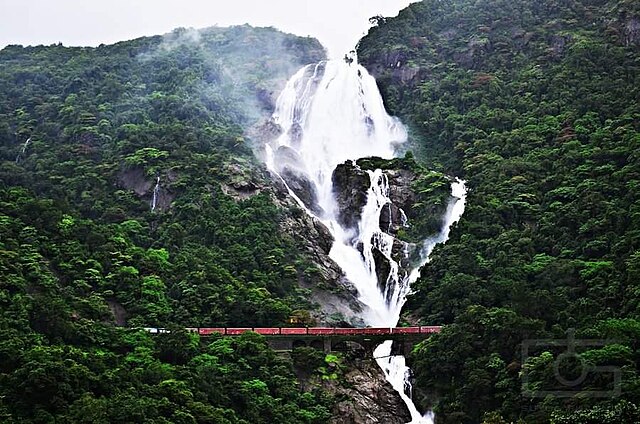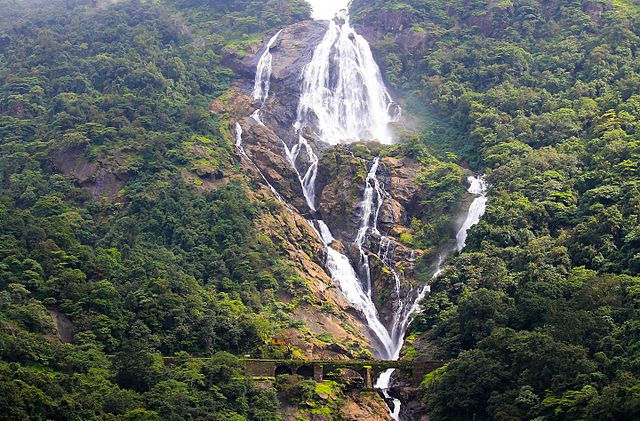Dudhsagar Falls, located in the Western Ghats of India, stands as a majestic testament to nature’s artistry. The cascade’s origins intertwine with historical legends, adding allure to its mesmerizing appeal.
Historical Significance

The legend behind Dudhsagar Falls dates back to ancient times. It is said that the waterfall was formed when a beautiful princess poured milk to form a curtain, concealing herself from a prince. The origin story has been passed down through generations, adding an enchanting aura to the falls.
Geographical Location and Surroundings
Nestled amidst the Western Ghats, Dudhsagar Falls sits within a lush, biodiverse ecosystem. The surrounding forests house a plethora of flora and fauna, contributing to the falls’ picturesque setting. The monsoon season transforms the cascade into a roaring giant, while the dry months offer a different yet equally mesmerizing view.
The Magnificent Appearance
The grandeur of Dudhsagar Falls is unparalleled. Its waters cascade down steep cliffs, resembling a stream of milk pouring from a height, creating a spectacle that captivates all who behold it. The changing seasons paint varying portraits of this natural wonder, each one as captivating as the last.
Adventure and Activities
Beyond its stunning beauty, Dudhsagar Falls offers adventure seekers a playground. Trekking trails wind through the lush forests, providing a closer encounter with nature’s splendor. Wildlife enthusiasts find joy in spotting unique species, while photographers cherish the opportunity to capture the essence of this cascading marvel.
Local Culture and Traditions
The falls hold immense cultural significance for the nearby communities. Local festivals and traditions are often intertwined with the waterfall’s presence, showcasing the seamless blend of nature and culture.
Conservation Efforts
Preserving the ecosystem around Dudhsagar Falls is of paramount importance. Various initiatives are in place to ensure the sustainability and protection of this natural treasure for generations to come.
Tourism and Accessibility
Reaching Dudhsagar Falls involves a journey through picturesque landscapes. Tips for visitors include the best times to visit, modes of transport, and essential precautions for a fulfilling experience.
Popular Myths or Stories
Folklore and myths add layers of intrigue to Dudhsagar Falls, fostering a sense of wonder among visitors. These tales have become an integral part of the falls’ mystique.
Comparisons and Unique Features
While Dudhsagar Falls stands out for its beauty, comparing it with other famous waterfalls highlights its unique attributes and distinctive charm.
Impact on Surrounding Communities
The falls contribute to the livelihood of nearby residents, shaping their culture, economy, and daily lives in profound ways.
Frequent Visitors’ Experience
Visitors share anecdotes and experiences, offering insights into the personal connections formed with Dudhsagar Falls.
Future Prospects
Considering potential developments or changes around the falls, there’s a balance to strike between accessibility and preservation, ensuring its allure endures for future generations.
Conclusion
In the heart of the Western Ghats lies a spectacle that transcends mere natural beauty. Dudhsagar Falls isn’t just a cascade of water; it’s a narrative etched in history, a haven for adventurers, and a source of cultural richness. Its milky waters cascade down cliffs, weaving tales of ancient legends and captivating all who gaze upon its majesty.
This breathtaking wonder isn’t just a destination; it’s an experience. From the vibrant flora and fauna that call its surroundings home to the traditions woven around its presence, Dudhsagar Falls immerses visitors in a tapestry of nature and culture.
Preserving this marvel is pivotal for the generations to come. Efforts towards conservation stand as guardians, ensuring that this natural treasure continues to mesmerize, educate, and inspire.
Visiting Dudhsagar Falls isn’t just about witnessing nature’s grandeur; it’s about becoming part of its story. As visitors come and go, they leave a piece of themselves amidst the cascading waters, carrying memories that linger, enriching their lives forever.
The journey into Dudhsagar Falls isn’t merely a physical one; it’s a voyage into enchantment, leaving an indelible mark on the soul of every traveler.
FAQs
What’s the optimal time to explore Dudhsagar Falls?
The best time to visit Dudhsagar Falls is during the post-monsoon season, from October to February when the weather is pleasant, and the waterfall is at its fullest. However, the monsoon season, from June to September, showcases the falls in all its roaring glory, albeit with limited accessibility due to safety concerns.
Are there any safety precautions one should take while trekking to the falls?
Yes, trekking to Dudhsagar Falls requires caution. It’s advisable to trek in groups, wear sturdy footwear, carry sufficient water and snacks, and be mindful of slippery paths, especially during the monsoon season. Following designated trails and heeding local guides’ advice enhances safety.
Can visitors swim at Dudhsagar Falls?
Swimming near the falls is not recommended due to strong currents and unpredictable water levels, especially during the monsoon when the water flow is vigorous. Safety precautions should be a priority, and visitors are advised to refrain from swimming in the waterfall’s immediate vicinity.
How long does it take to reach Dudhsagar from nearby towns?
The journey to Dudhsagar Falls varies based on the mode of transport and starting point. From Goa, the closest major city, it takes approximately 1.5 to 2 hours by road to reach the falls. Trekking from nearby railway stations like Castle Rock or Kulem can take around 3 to 4 hours, offering a scenic route through the wilderness.
Are there any restrictions on photography near the falls?
While photography is welcome, some areas may restrict it for safety or conservation. It’s crucial to honor these guidelines, especially near the waterfall or sensitive ecological zones, preserving Dudhsagar Falls’ natural beauty for future visitors.


